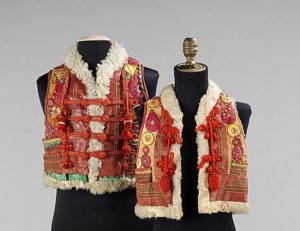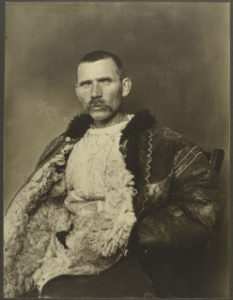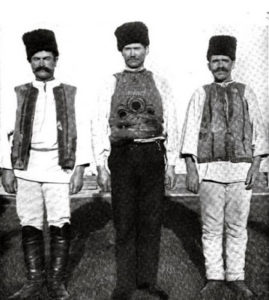Stinky Vest
Cathy M. Koos
At the advanced age of 87, my grandfather Daniel Koos traveled back to his home village of Kokava, Slovakia. He had not been back to the Old Country since his youth – 70 years. While he had corresponded with his sister all those many years, Slovakia was behind the Iron Curtain and off limits to Western visitors. But after the Prague Spring, a grand day came in 1969 and accompanied by a couple of my aunts, Grandpa was able to make the arduous trip to his old home.
Grandpa brought back some amazing souvenirs including a carved walking stick, an interesting linen textile and a stinky lambskin vest. I still have the textile – a finely woven linen about 10 feet long and 4 feet wide embroidered in red on each long end. Not a clue its purpose – perhaps a top and bottom sheet? I use it as a tablecloth when I am serving a crowd.

Slovak vests, Metropolitan Museum
Now back to that stinky vest. Lovely thing it was, with suede-side out and lambswool inside. Colorfully embroidered with magnificent skill, but it stunk to high heaven. Grandpa gifted the vest to my dad, who promptly hung it in the garage for an entire cold Pennsylvania winter, in the hopes the stink would go away. Alas, after freezing for a whole winter and baking for an entire summer, we had come to the sad conclusion it smelled even worse.
My dad, an organic chemist, even took the vest to his lab at the USDA. They had a hide tanning project going at the time and their highly scientific sniff tests revealed that the sheepskin was tanned with urine and chicken feces. The smell never went away and sadly, the beautiful vest was relegated to the bin.

Romanian Shepherd, Ellis Island Archives
The memory of the vest led me on an exploration of these fancy embroidered waistcoats, and I learned that they are symbolic and representative of a particular village.
Not only are these sheepskins waistcoats practical for keeping the wearer warm, but they are embroidered or beaded with ancient symbols and designs. Similarly, folk clothing is colorful and ornately decorated which expresses an identity and embraces a vanishing culture.

(Montenegrian Gunj Short Immigration Archives)